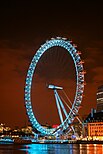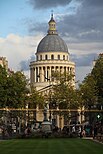Lomercoyne
Lomercoyne Fasburdas Lomercoyne (Leucish) | |
|---|---|
| Nickname(s): Octavia of the Cymon River | |
 The Federal Capital District, also known as Greater Lomercoyne (gray) | |
 Location within the Northern Kingdom | |
| Sovereign state | Chatten and Leucen |
| Nation | Leucen |
| Island | Leucen |
| Federal district | Federal Capital District |
| Settled by the Leucyn | before 100 BCE; 2124 years ago, as Loumorcynn |
| Administrative HQ | Horessen Palace 4°1'W 53°26'N |
| Demonym(s) | Lommies |
| Government | Mayor-council government and deliberative assembly |
• Mayor | Jayer Insignia |
| 33 constituencies | |
| 5 representatives | |
| Area | |
• Total | 1,844.07 km2 (712.00 sq mi) |
• Urban | 2,025.37 km2 (782 sq mi) |
• Metro | 9,163.37 km2 (3,539 sq mi) |
| Elevation | 8 m (26.24 ft) |
| Highest elevation | 109 m (367.61 ft) |
| Lowest elevation | 0 m (0 ft) |
| Population | |
• 2020 estimate | 12,091,555 |
• Urban (2020) | 9,332,435 |
• Metro (2020) | 15,712,334 |
• Density | 5,640/km2 (14,607.5/sq mi) |
| GDP | 2021 estimate |
• Total | ₽389.5 billion |
• Per capita | ₽77,815 |
| HDI (2019) | very high |
| Currency | Leucenian Piese (PIS) |
| Time zone | UTC+1 (NWT) |
• Summer (DST) | UTC+2 (CDT) |
| Driving side | right |
| Calling code | +115 |
| ISO 3166 code | NK-LC |
| Internet TLD | .chl |
| Website | lomercoyne.gov.ch |
Lomercoyne, formally the City of Lomercoyne, nicknamed the "Octavia of the Cymon River" and popularly known as Lommy, is the capital city and a federal district located in the Federal Capital District of Chatten and Leucen. The city is conveniently located between the federal states of Paworys and South-west Leucen. Situated on the River Cymon, the longest river in Great Chalcain, its access to the Crowergynn Sea through Cymon makes it a continuously inhabited settlement for 2,500 years. Its ancient core, commonly called the Lomerynum, was originally the approximate location of an indigenous city inhabited by a Proto-chalcerean tribe known as the Leucyn. It serves as the historic and contemporary capital of the country, from the period of Tridetarchy when it serves as the capital of Leucen, during the rule of the Moravs when it became the administrative center of Moravian Leucenia, and through-out medieval and contemporary history. Serving as the home of the government and the Parliament for a millennia, the city bears the status as the political, financial, cultural, and technological center of the Northern Kingdom. In the 19th century, Lomercoyne grew rapidly during the Turembelian, Nethanian, and Crowberwynnian eras, quickly recovering from the disastrous Constitutional Revolution of 1801. It plays a significant role on the rise of liberalism during the Century of Revolutions and the 1935 July Revolution. Briefly becoming the largest city on Callys during the 19th century, its expansion led to the absorption of surrounding counties such as Sharram, Tremmen, and Cywun. By 1975, the city gains a total of 33 communisalles, necessitating the formation of a federal district. Both the federal district and the administrative region is governed by the Greater Lomercoyne Development Authority.
As one of the world's global cities, Lomercoyne exerts enormous influence in world's art, commerce, transport, science, media, finance, education, healthcare, entertainment, fashion, technology, tourism, and communications. As a member of the Callyssian Network of Capital Cities, Lomercoyne is among one of Callys' economically powerful cities and one of the world's financial centres, with the earliest stock exchange established in Lomercoyne in 1511. It hosts Callys' largest concentration of higher educational institutions, some of which are the highest-ranked educational institutions in the world: Crowberwynn University of Institute and Technology for STEM studies, Lomercoyne School of Economics for business and economics, Metropolitan University for fine arts, literature, and philosophy, and the comprehensive University of Lomercoyne, one of the oldest universities in the world. It has the world's second busiest airport and is home to the world's oldest rapid-transit system.
Lomercoyne's urban culture encompasses many languages. It is the most populous city in the Northern Kingdom, with its metropolitan area having the total population of 16 million inhabitants, making it a megacity. One-fourth of the population of the island of Leucen and approximately 17% of the entire population lives in this city. Four World Heritage Sites are located in Lomercoyne: the gardens and plazas surrounding Horessen Palace; The Septium and its vicinity, Cemetery of Kings, the surviving parts of Wall Rygusta, and Moravian Bathhouses; Bridge of Lomercoyne; and Reiro's Monument. Other landmarks include The Wheel, Cydacyll Avenue, Jark Syde Park, Metropolitan Museum of Fine Arts, and the numerous theaters at Sojo. Some of the world's largest museums and art theaters are located in Lomercoyne: the Chalcish Museum; the Museum Complex, which is composed of the following: Federal Museum of Anthropology, Federal Museum of Fine Arts, Turembel Planetarium, and the Federal Museum of Natural History; the Metropolitan Art Theater, Ardawynn Museum, and the Grand Exhibit. Lomercoyne hosts the Northern Kingdom's largest zoo: the Lomercoyne Urban Zoo, and the second-largest water park: the Lomercoyne Water Park. Some of the sports events such as Callyssian Grand Prix and the Lomercoynian Grand Marathon occurs annually in the city.
Toponomy
The name "Lomercoyne" was derived from an ancient settlement known as Loumorcynn, home of the proto-chalcerean tribe called Leucyn, which was approximated to be located in Lomerynum, Lomercoyne's historical core district. An ancient name, the name was derived from an largely unknown, extinct language: Proto-Chalcish, the origin of all Chalcish languages. Modern scientific analyses of the name concludes that a derivation of the name is present through-out all of the contemporary Chalcish languages: Lomourcun in Rwycorrish, Llumucaine in Porgynthian, Lomocynn in Terkovish, and Luumurcoin in Chattish. Attempts on linguistic construction of the name's origin led to the Proto-Chalcish word Loumerjound or something similar. The name then evolved into Loumercoyne with the borrowing of the consonant -y from the Vauns, and the vowel -i from the Terks. By the time the Moravs arrived on the Chalcish Isles, the modern word that is Lomercoyne was already widely used.
History
Administration
Geography
Demography
Economy
Transportation
Transport is one of the main policies administered by the Mayor of Lomercoyne and the City Council of Lomercoyne, though their administrative powers only extends to within the borders of the Federal Capital District. The Mayor and the City Council assembles within Lomercoyne City Hall with the members of the Greater Lomercoyne Development Authority, which is mostly experts and professionals on their field. Major transportation lines such as Lomercoyne Downlines, Lomercoyne Uplines, Lomercoyne Carousel, Grand Tramways, Roster Aviation and Cymon Ferries are administered by the Transportation for Lomercoyne (TFL), itself an agency of the Ministry of Transportation, which started by 1967.
After the end of the Second World War, several transport cooperatives and organizations banded together to form the Lomercoyne Passenger Transport Board. In 1967, increasing demand for public transportation coinciding with the ongoing pedestrianisation allowed the Ministry of Transportation to establish an administrative agency called Transportation for Lomercoyne. The next year, Lomercoyne Transportation Franchising and Regulatory Board was established by the Greater Lomercoyne Development Authority to regulate vehicle ownership and authenticity and detect colorum vehicles. TFL is represented in the City Council by a commissioner, which, together with the board, is appointed by the Mayor of Lomercoyne.
Aviation

Aviation in Lomercoyne is administered by the Roster Aviation. Lomercoyne is the primary hub for long-haul routes crossing through Septentriones Ocean, majority arriving from the Federal States, making it one of the world's busiest city airspaces. There are a total of ten airports serving Lomercoyne, but most in-bound airlines only passes through seven of those. The rest are used for general aviation and emergency purposes.
The airports of Lomercoyne are divided into civilian airports, which handle most of the metro's annual passengers, and military airports, which is exclusively used by the Royal Air Force.
- Locus-Ardynn International Airport in a panhandle area near the border of the city in southern Tremmen, was once the busiest airport in modern history until it was surpassed by Rookesrow International Airport of Avrecenia, Federal States. It is the major hub for international traffic and is currently the home of the Northern Kingdom's flag carrier, the Chalcish Airways.
- Hargenydd Airport is located in Ribbing, the closest airport to the downtown Lomercoyne, and is also the first airport to be constructed in the city, which was operating since 1899. Once the primary airport for the city, it still remains as the largest NK airport in terms of flight schedules and is the main hub of a low-cost airline called AirCallys. The airport is set to be demolished by 2027 due to security reasons and its proximity to Horessen Palace.
- Lomercoyne Curwynnad Airport, located in Cywun to the south, handles continental flights and long-haul routes. The main hub of AxianAir, the largest airline in terms of annual passengers, is located here.
- Lomercoyne Strasheidd Airport known for its short runways and exclusive access, is the major airport for business and luxurious travellers, with both full-service short and long-haul flights; and private jets using the airport as their gateway to the city. Because of considerable air traffic in other airports, the airport is located in the Howrynn near the metro's western border.
- Klauber Airport, to the north of the metro in the federal state of Paworys, is the only airport not located within the boundaries of Lomercoyne. 95% of incoming passengers comes from international flights. It is a developing airport with a growing number of airlines stationed within.
- Merwick Jonwynn Airport to the south-east of Lomercoyne in Sykotos is used by several budget airlines for short-haul flights.
- Nethania Airport to the eastern border of Eydersynn is a royal property exclusively for use by the members of the royal family. The annual cost of the airport is paid directly by the Crown.
Rail
Underground railways
Suburban
There are 360 railway stations covered under the Lomercoyne Citycard System where payments through Citycard is available. Lomercoyne south of River Cymon has the huge concentration of overhead railways. Most lines terminate at the Lomerynum. The Inner Lomercoyne terminals, a series of terminals located within the Old City and inside C-1, primarily serves the downtown center. The CymonLink, a rail line running parallel to the river Cymon that runs east to west, was built in 1989 and currently serves passengers going to the central part of the city. The VertiLink also serves the same purpose, instead running from north to south.








